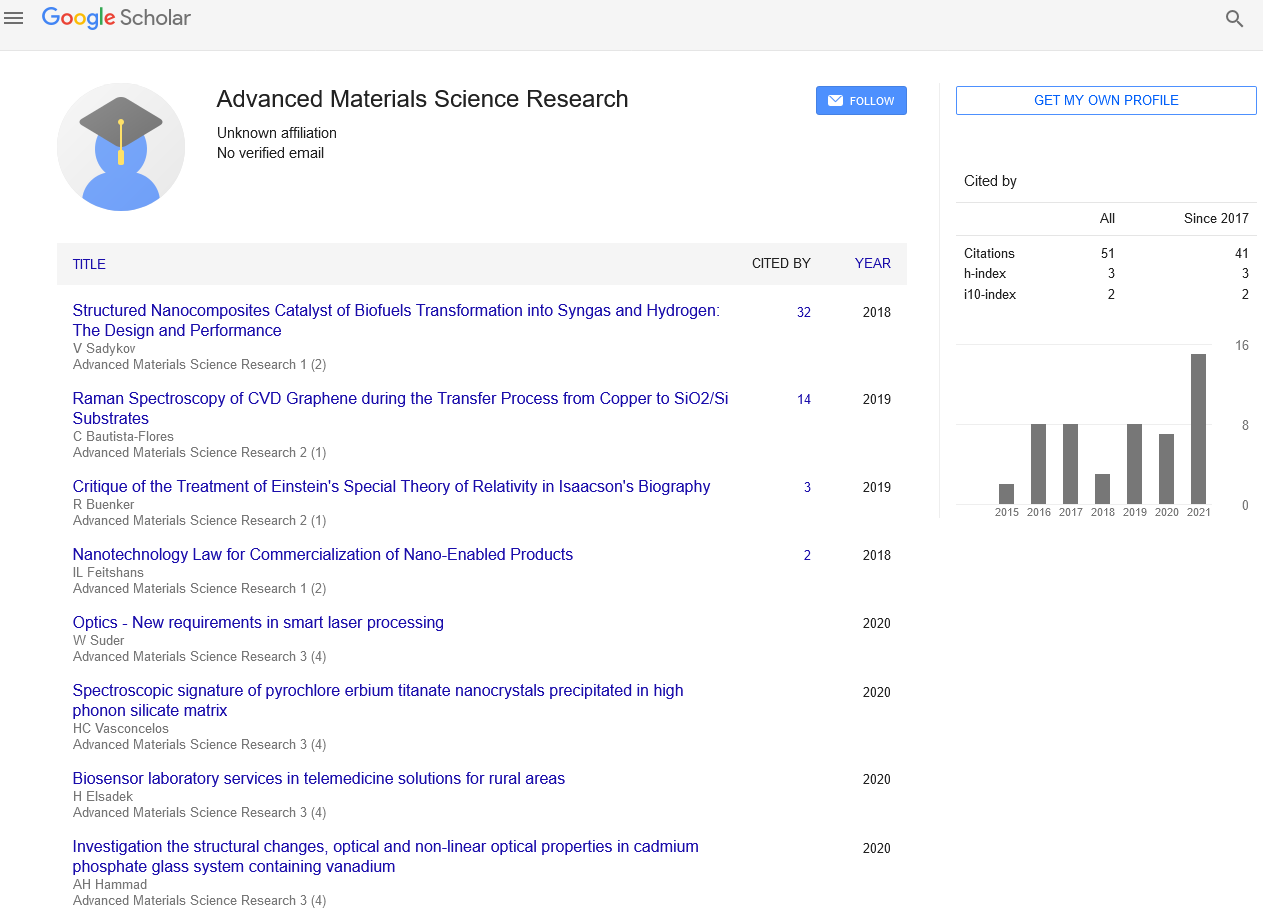Short Communication - Advanced Materials Science Research (2023) Volume 6, Issue 2
A Short Note on Materials, techniques and biomedical applications
Stephanie Mikos*
Department of Material science Ethiopia
Department of Material science Ethiopia
E-mail: Stephanie_m5@gmail.com
Received: 03-Apr-2023, Manuscript No. AAAMSR-23-97138; Editor assigned: 05-Apr-2023, Pre-QC No. AAAMSR-23-97138 (PQ); Reviewed: 19-Apr-2023, QC No. AAAMSR-23-97138; Revised: 21-Apr-2023, Manuscript No. AAAMSR-23-97138 (R); Published: 28-Apr-2023; DOI: 10.37532/ aaasmr.2023.6(2).37-39
Abstract
Due to their capacity to self-degrade within the body, biodegradable metals emerged as promising candidates for fracture fixation devices. The devices face the greatest difficulties in achieving a sufficient degradation rate in relation to bone healing and providing safe degradation by-products. Magnesium alloys are the subject of intense research due to their promising properties; however, the hydrogen evolution that occurs during corrosion in aqueous media prevents their use in biomedical devices. Comparing treated and untreated AZ91 alloys, this study examines how the low potential anodizing process affects surface topography, electrochemical response, hydrogen evolution, and cell attachment in basic media. The degradation rate is also evaluated using a comparative method of determining the electrochemical parameters. Magnesium oxide/hydroxide can be formed on the surface of anodized aluminum by electrochemically treating it at a low voltage in a 5 mol/L KOH solution. This magnesium oxide/hydroxide could serve as a barrier to slow down the material's degradation and, as a result, reduce the amount of hydrogen released. In turn, this treatment made it easier for MCT3T3 pre-osteoblastic cells and bovine embryonic fibroblasts (BEFs) to stick to the surface, indicating that it could be used in temporary implants.c
Keywords
Materials • Biomedical applications • Magnesium oxide/hydroxide
Introduction
Implant-required osseous fractures are typically treated with stainless steel, titanium, or chromium cobalt alloys. However, these materials frequently cause issues with stress shielding, necessitating a second removal procedure once bone functionality has been restored. Careful mediations generally infer wellbeing dangers, for example, intra clinic gained diseases, recuperation time and financial expenses for the medical services framework. Because of these factors, biomaterials research is currently focusing on the search for biodegradable materials for temporary implants. Polymers like poly-lactic acid (PLA) and poly-glycolic acid (PGA) and their copolymers make up the majority of biodegradable devices that are available for purchase. Due to their poor mechanical properties—most notably, their unsatisfactory mechanical strength these materials, on the other hand, are primarily used in applications with low or moderate load bearing requirements. As a result, new biocompatible and biodegradable materials are required for osseous fracture treatment biomedical devices.
Because their mechanical properties are superior to those of polymers, biodegradable metals emerged as promising candidates for fracture fixation devices. Magnesium (Mg) alloys have gained popularity primarily due to their high biodegradability. Despite the fact that Mg amalgams enjoy benefits contrasted with dormant metallic biomaterials, e.g., great mechanical properties, biocompatibility, and solidarity to-weight proportion, these combinations likewise have unfortunate consumption safe properties in forceful arrangements (e.g., natural medium). Mg-based alloys, in particular, are of great interest because their properties are comparable to those of human bone; primarily, their specific density (1.74–2 g/cm3) as opposed to bone's 1.8–2.1 g/cm3) and Young's modulus (41–45 GPa versus bone's 3–20 GPa). Pure magnesium has an elastic modulus of 45 GPa, which is even closer to that of bone than titanium is. In any case, the unfortunate consumption opposition prompts embed corruption before the mending system is finished, and the accompanying hydrogen advancement can defer the recuperating system or even reason soluble harming. Magnesium amalgams are perceived as an option in contrast to tempered steel because of its lower weight and high solidarity to-weight proportion. Although magnesium implants typically release a manageable amount of metallic ions into the body, these ions may be absorbed by the tissues and released through the kidneys eventually.
Along these lines, Mg presents magnificent biocompatibility, since it is a component present in the human body, and it is expected for a few metabolic cycles. The principal constraint for the utilization of Mg-combinations in biomedical gadgets is the hydrogen development that outcomes from their erosion in watery media, as referenced previously. When embedded in the living being, the nearby arrival of hydrogen produces gas pockets in the tissue, possibly prompting expanding and torment. As a result, the goal of research on magnesium alloys for implant applications is to reduce hydrogen release by lowering the degradation rate. A number of approaches have been suggested for the Mg-based metals to accomplish this, including surface treatments (such as chromate or phosphate treatments), anodizing, coating (such as calcium or polymer-based coatings), and galvanizing/electroplating, all of which are done outside of the natural oxide layer that can be formed on the magnesium surface. As a result, a number of surface modifications have been applied to Mg alloys to alter their surface reactivity, but not all of them are suitable for use in the body.
Surface modification facilitates the optimal rate of magnesium ion release into the human body by creating a barrier between the substrate and the hostile environment. According to previous research, the corrosion resistance of various Mg alloys that were subjected to high and medium potential anodizing processes was found to be superior to that of non-anodized metal. The process of anodizing, also known as anodic oxidation, involves electrolytic passivation, which results in the formation of a stable and protective oxide film on the surface of the metal. The thickness of this film can be altered by varying the electrolyte (concentration and pH), potential (or current density), and temperature [1-5].
Discussion
These researches also demonstrate that distinct Mg alloys resulted in distinct compositions of protective layers. The purpose of this study was to develop a potential material for fracture fixation devices by employing a low voltage anodizing process and a magnesium alloy with the best mechanical properties for implant devices, the AZ91 alloy. The hydrogen evolution rate of the AZ91 alloy was chosen over that of pure Mg and other alloys like ZE41. When compared to coatings and the high voltage anodizing process, the anodizing surface treatment was chosen due to its low cost, environmental friendliness, and lack of toxic ingredients. As a result, the surface properties and behavior of in vitro corrosion of anodized AZ91 were used to define the material. Additionally, the material's direct contact with living cells was examined for potential cytotoxic effects. Two cell types significant in bone recovery process were utilized: osteoblast precursors, which later differentiate into osteoblasts that deposit osteoid, and fibroblasts, which are among the first cells that migrate and generate a stroma that supports vascular ingrowth following implantation surgery.
In the current scenario, the biomedical application relies heavily on additive manufacturing. Present examination is centered on the development of added substances and their cycles to build the 3D article and the correlation of the most recent exploration in biomedical use. The point is to characterize, look at and assess the fitting biomedical application for added substance creation in biomedical applications. For biomedical applications and the fabrication or reinforcement of materials with the basis material (PLA), the purpose of this review is to identify the sustainable and biodegradable material for which Polylactic acid and its characterization are compared and analyzed.
The method of product development that is most favorable, appealing, and potentially useful can be used as an example of additive manufacturing. The process of joining various materials to construct objects from a threedimensional model is another way that additive manufacturing (AM) can be explained. Added substance Assembling is otherwise called Added substance Creation, Added substance procedures, Added substance layer Assembling and freestyle manufacture. Added substance fabricating is otherwise called 3D printing. Additive processes are used to create a 3D-printed object. In 3D printing, an item is made by setting down progressive layers or material the article is shaped. The opposite of subtractive manufacturing, AM involves extruding a small amount of metal, plastic, or any other material, like PLA or ABS. When compared to conventional manufacturing methods, 3D printing can produce intricate shapes with a smaller amount of material. The ebb and flow research shows the added substance assembling and material determination of biomedical applications [6-10].
Conclusion
The most important property of single crystals is material anisotropic behavior, which is caused by the different physical and chemical properties in different crystalline orientations and planes. Body centered cubic (BCC), face centered cubic (FCC), and hexagonal closest packing (HCP) are the three most prevalent crystalline structures found in metals. Throughout recent many years, the greater part of studies center around exploring the machinability of the single gem metals with FCC translucent designs, essentially including single gem copper (Cu), aluminum (Al), and nickel (Ni) superalloy.
References
- Kayser MS, Dalmau J. Anti-NMDA receptor encephalitis autoimmunity and psychosis. Schizophr Res. 176, 36–40 (2007).
- Downar J, Daskalakis ZJ. New targets for rTMS in depression: a review of convergent evidence. Brain Stimul. 6, 231–240 (2013).
- Mulders PC, Eijndhoven PF, Schene AH et al. Resting-state functional connectivity in major depressive disorder a review. Neurosci Biobehav Rev. 56, 330–344 (2015).
- Nielsen DA, Utrankar A, Reyes JA et al. Epigenetics of drug abuse predisposition or response. Pharmacogenomics. 13, 1149–1160 (2012).
- Ajonijebu DC, Abboussi O, Russell VA et al. Epigenetics a link between addiction and social environment. Cell Mol Life Sci. 74, 2735–2747 (2017).
- Pescosolido BA, Martin JK, Long JS et al. A disease like any other A decade of change in public reactions to schizophrenia, depression, and alcohol dependence. Am J Psychiatry. 167, 1321–1330 (2010).
- Malla A, Joober R, Garcia A. Mental illness is like any other medical illness a critical examination of the statement and its impact on patient care and society. J Psychiatry Neurosci. 40, 147–150 (2015).
- Ross DA, Travis MJ, Arbuckle MR. The future of psychiatry as clinical neuroscience why not now. JAMA Psychiatry. 72, 413–414.
- Traicu A, Joober R. The value of a skeptical approach to neurosciences in psychiatric training and practice. J Psychiatry Neurosci. 42, 363–365 (2017).
- Tandon R, Rankupalli B, Suryadevara U et al. Psychiatry is a clinical neuroscience, but how do we move the field. Asian J Psychiatr. 17, 135–137 (2015).
Indexed at, Google Scholar, Crossref
Indexed at, Google Scholar, Crossref
Indexed at, Google Scholar, Crossref
Indexed at, Google Scholar, Crossref
Indexed at, Google Scholar, Crossref
Indexed at, Google Scholar, Crossref
Indexed at, Google Scholar, Crossref
Indexed at, Google Scholar, Crossref
Indexed at, Google Scholar, Crossref

